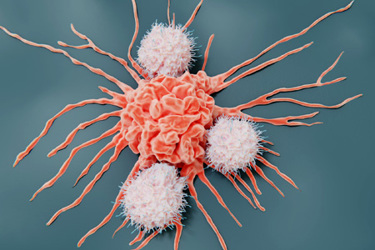The Future of Cancer Immunotherapy Through Allogeneic NK Cell Innovation

By Erin Harris, Editor-In-Chief, Cell & Gene
Follow Me On Twitter @ErinHarris_1

Natural killer (NK) cell therapies are rapidly emerging as a transformative force in cancer immunotherapy. Our recent Cell & Gene Live, Building The Future Of Cancer Immunotherapy Through Allogeneic NK Cell Innovation, took a deep dive into this very topic. I was joined by two leaders at the forefront of the NK cell therapy movement, Raphaël Ognar, President and CEO of NKILT Therapeutics and Tracy Ryan, Co-Founder and CCO of NKore BioTherapeutics. Together, we dissected the state of NK cell science, persistence challenges, safety, scalability, and the unique engineering breakthroughs shaping the future of oncology care.
Why NK Cells Now?
NK cells have historically been overshadowed by T cell therapies but are gaining traction because of their innate ability to target and kill cancer cells without the need for prior sensitization. They also have a much lower risk of severe toxicities such as cytokine release syndrome. Ryan, drawing on both professional and deeply personal experience (her own daughter was an early patient undergoing NK cell therapy for a brain tumor), emphasized that the safety profile of NK cells is incredible, allowing for treatment of heavily pretreated, fragile patients who had run out of options. “We’re starting to see efficacy, particularly in solid tumors where others have failed, and patients’ quality of life is dramatically improved,” she said.
Ognar echoed Ryan’s optimism, underscoring three foundational pillars: the accelerating science demonstrating that properly engineered or activated NK cells can kill cancer; the cells’ innate and adaptive killing capacity; and their potential for scalable, allogeneic manufacturing. He shared that autologous CAR-T requires complex, patient-specific manufacturing, while NK cells can theoretically be produced in bulk, reducing costs and expanding access.
Engineering NK Cells for Clinical Impact
A strong consensus between our panelists was the necessity to engineer NK cells with strategies tailored to their unique biology, not merely repurpose T cell engineering techniques. “While T cells depend on antigen-driven activation, NK cells operate through a balance of activating and inhibitory receptors, requiring a tailored playbook, not a recycled one,” Ryan shared. Borrowing T cell strategies risks rapid cell exhaustion or undermining NK cells’ inherent safety advantage. Both NKILT and NKore are advancing proprietary methods to overcome historic hurdles of NK cell persistence, potency, and tumor infiltration.
Ognar explained that NKILT’s chimeric ILT receptor platform is designed not only for precise tumor targeting but also for sustained activation, allowing NK cells to feed and re-stimulate themselves after engagement. “We’ve pushed functional persistence well beyond the supposed two-week threshold, achieving up to six weeks of active, serial killing in preclinical models,” he said. “This longer persistence can translate into fewer cells and lower doses per patient with reduced risk and manufacturing burden.”
Ryan detailed NKore’s distinctive approach combining osteoclast-derived cells and probiotic bacterial stimulation to supercharge their NK cell populations. “We are seeing patients maintain elevated functional NK cell counts a year after infusion with continual tumor regression and immune system reconstruction,” she said. “This orthogonal mechanism of action offers hope for both solid tumors and hematologic malignancies, potentially enabling remission and long-term immune reconditioning.”
Safety and Clinical Trial Design
The safety profile of NK cell therapies was a recurring theme throughout our discussion, with self-regulation through NK-specific receptor checkpoints providing intrinsic protection against GvHD and other complications. Ryan recounted how, even in a cohort involving her own daughter, no severe adverse events were observed across dozens of infusions, either in the clinic or in hundreds of animal models. Stringent safety monitoring is central to both companies’ protocols, including real-time cytokine profiling, close organ function tracking, and rigorous pre- and post-infusion assessments. These careful clinical designs not only protect patients but also provide high-confidence data for regulators and adopting physicians, supporting the argument that NK therapies are ready for prime time.
Manufacturing, Scalability, and Global Access of NK Cell Therapies
According to both Ryan and Ognar, allogeneic NK cell therapies offer profound advantages over autologous T cell platforms in terms of manufacturing scalability, batch expansion, and global distribution potential. Ryan described how blood banks and proprietary expansion methods allow for production of very large batches from single donors, which are then cryopreserved and shipped globally. Both panelists share a vision of making cell therapy available not only through clinical trials in U.S. or EU settings, but also via expanded access and palliative channels in countries such as Mexico, India, and Dubai.
“We’re up against technical challenges, but variability between donors, optimal cryopreservation, and identifying predictive markers for high performance cells,” Ognar stated. “A decade from now, we’ll look back and wonder why anyone doubted we could do this at scale.”
Challenges and Unanswered Questions for NK Cells
Despite recent progress, Ognar and Ryan agreed that certain hurdles remain, including optimal donor selection, which prevents immune rejection or cell depletion. Patient selection remains rigorous with careful evaluation to ensure that travel, comorbidities, or borderline organ function don’t introduce unnecessary risk. Both panelists acknowledged the reality of technical bumps in freezing, storage, and transportation, although advances in cryopreservation and logistics are quickly dispelling these as fundamental roadblocks.
What’s Next for NK Cell Therapy
Our panelists’ insights clearly revealed that advancements in NK-specific engineering, allogeneic manufacturing, and safety monitoring are converging to redefine what cell therapy can achieve across both liquid and solid tumors. As off-the-shelf solutions become achievable and affordable, hope is growing that this next generation of immunotherapy will reach far more patients, far more quickly, and with fewer adverse effects than in the past. “Our field awaits pivotal trial data and regulatory progress, but the scientific and commercial groundwork has never looked stronger,” said Ryan.
Ognar and Ryan shared compelling insight and timely data throughout our discussion far beyond what is included in this summary. Check out the full-length on-demand version for a deeper dive.
